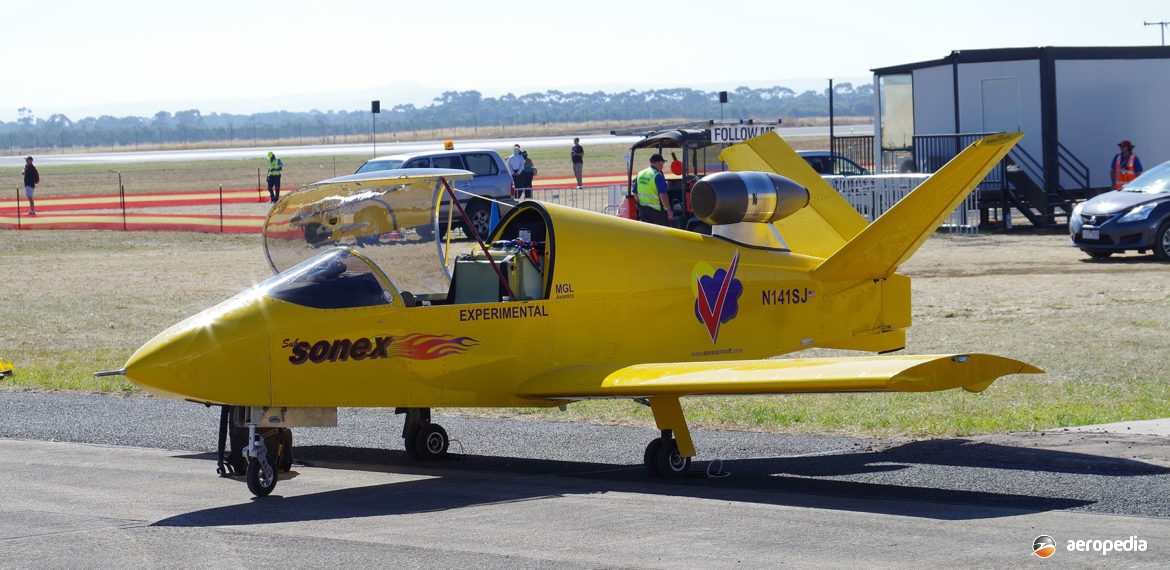Photograph:
Sonex Aircraft SubSonex JK-2 N141SJ (c/n 001) at the Australian International Airshow at Avalon, VIC in March 2017 (David C Eyre)
Country of origin:
United States of America
Description:
Single-seat light jet-powered sport aircraft
Power Plant:
One 247 lbst PBS JTJ-100 turbojet engine
Specifications:
- Wingspan: 5.48 m (18 ft)
- Length: 5.05 m (16 ft 6 in)
- Wing area: 5.57 m² (60.0 sq ft)
- Max level speed: 426 km/h (265 mph)
- Max cruising speed: 386 km/h (240 mph)
- Max rate of climb: 488 m/min (1,600 ft/min)
- Stalling speed in landing configuration: 93 km/h (58 mph)
- Stalling speed clean: 103 km/h (64 mph)
- Take-off roll: 366 m (1,200 ft)
- Landing roll: 762 m (2,500 ft)
- Range with 30 mins reserve: 772 km (480 miles)
- Fuel capacity: 151 litres (33 Imp gals)
- Empty weight: 227 kg (500 lb)
- Useful load in utility category: 227 kg (500 lb)
- Useful load in aerobatic category: 181 kg (400 lb)
- Max gross weight in utility category: 454 kg (1,000 lb)
History:
The SubSonex was designed by John Monnett and began as a dream in his mind for a personal sport jet that could be flown by someone with average to good pilot skills. The prototype proof-of-concept aircraft known as the JSX-1 was built and had a fixed undercarriage, making its first flight on 10 August 2011, completing the flight test program in 2012. This aircraft was refined to the JSX-2, the second prototype, which was basically the same as the first production aircraft. It was of all aluminium structure with some pop rivets for primary assemblies and solid rivets as required. Most of the aluminium panels were flat or had a single curvature. The outer wing panels were removable for transport, Sonex Aircraft offering a custom-built trailer to transport the aircraft.
The undercarriage was retracted and extended by a pneumatic system which included an air-pump behind the pilot and air lines running to each wheelwell. A small video camera was installed on the underside of the nose, looking backward, and the image of the undercarriage retraction could be displayed on the EFIS screen for the pilot if desired. The engine ws mounted to the top of the fuselage with two bolts which allowed for easy maintenance. The aircraft was certified in the Experimental category and was provided to the builder in kit form.
The JSX-2 had a larger cabin and a BRS ballistic parachute system, deliveries of kits commencing in 2014. The exhaust exited through a V-tail. The aircraft was developed by “The Hornets Nest” R & D team at Sonex Aircraft. The Team also developed an integrated smoke generator and fitted a five-point pilot harness.
The engine was the PBS TJ-100 turbine engine rated at 247 lb thrust which weighed 20.6 kg (45.4 lb). It was built in the Czech Republic and has been used on aircraft such as the Salto sailplane, an example of which has been demonstrated on a couple of occasions at the Australian International Airshow at Avalon, VIC. The engine was based on the hot-section of a Soviet APU and was compact, 62.5 cm long and 27.2 cm in diameter (24.6 inches by 10.7 inches), burning a variety of jet fuels, including Jet A-1, JP-5 or JP-8.
A number of examples of the kit of the Subsonex have been imported to Australia and have been constructed, the PBS TJ-100 turbojet engine being imported by Australian Aircraft Kits of Taree, NSW. One became VH-VOB (c/n KIT-009) to I M Young Pty Ltd of Coffs Harbour, NSW on 15 December 2018 and another became VH-VIR (c/n 0030) in October 2020 .

